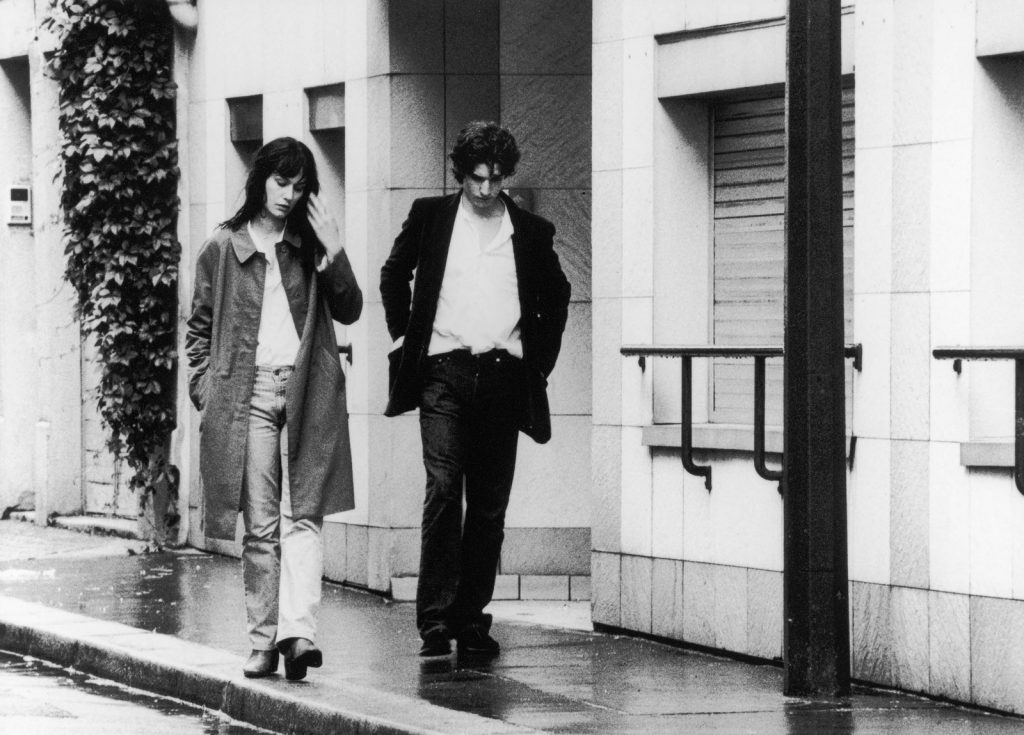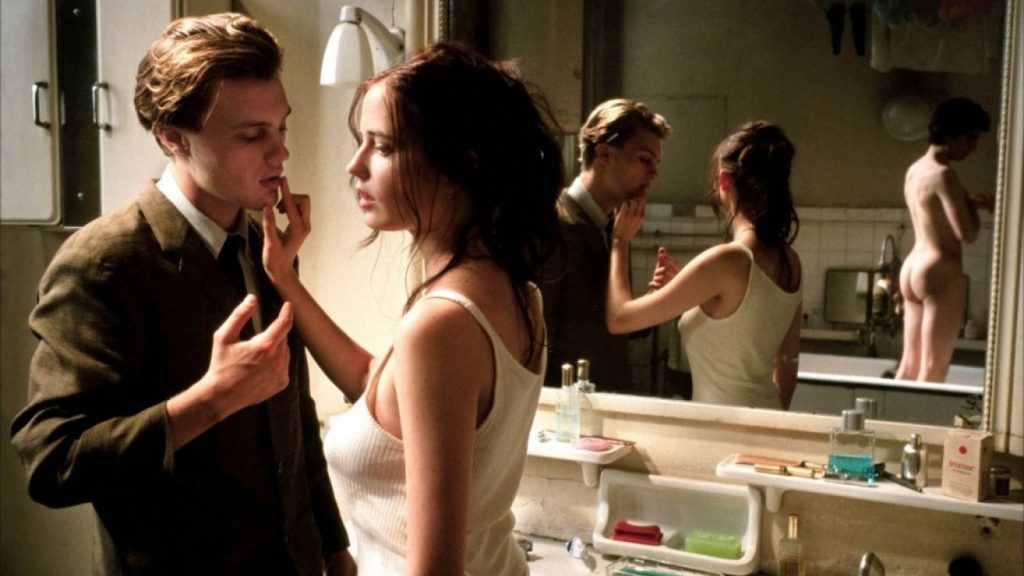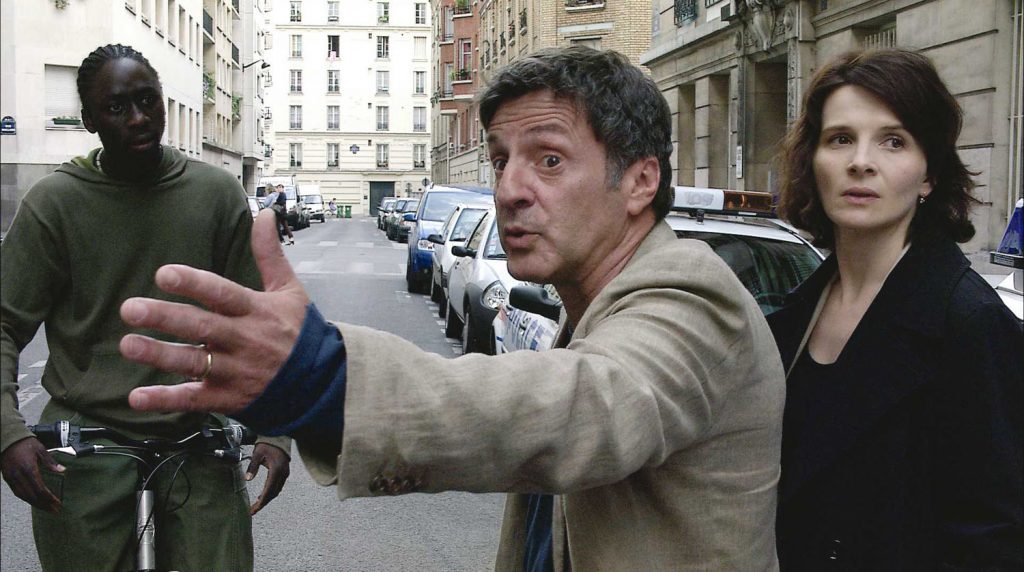
Back in the spring of 2018 I wrote an essay on Bernardo Bertolucci’s The Dreamers, in which I elaborated on the film’s stylistic strategies and the role of cinephilia as a mode of nostalghia in the dream world of the characters.
In Bernardo Bertolucci’s The Dreamers (2003), the beginning of the future is actually the end. The closing sequence of the film shows the erupting street violence of May 1968, featuring the three protagonists who just have been forced to join history. The brick that broke a window in the bourgeois apartment of Theo (Louis Garrel) and Isabelle (Eva Green) has definitively ended their narcissistic ménage à trois with quiet American Matthew (Michael Pitt).
This essay serves to illustrate the formal strategies that both constitute and emphasize the otherness of the protagonists’ idealized past. I argue that the cinephilia of Theo, Isabelle and Matthew and the topos of the apartment serve as clear markers of the fantasy world that the characters inhabit. With my decision to focus on the stylistic traits of The Dreamers only, I want to question and criticize the analytic approaches of Michael Leonard (2011) and Niels Niessen (2012), who drew comprehensible but unbalanced comparisons with Les Amants Réguliers (Philippe Garrel, 2005) respectively Caché (Michael Haneke, 2005) to criticize or even dismantle the narrative and stylistic direction of The Dreamers.

Cinephilia
The Dreamers introduces its main character when he is watching a film.[1] The overture is a prototypical outline of the socio-cultural climate that was enchanting Paris at that time. Cinephiles from France loved American movies: Francois Truffaut interviewed Alfred Hitchcock, the Cinémathèque Française and the cineclubs in the city center constantly facilitated screenings and lively discussions of the classics.[2] Matthew meets Isabelle at the entrance of the Cinémathèque, where young film buffs are protesting against the threat of Henri Langlois’ possible discharge.[3] Isabelle and her sibling brother Theo invite Matthew at their home, and the rest is history – or actually, a flight from history.
Isabelle and Theo amuse themselves with playful re-enactments of canonical movie scenes.[4] Classics include Scarface (1932), Der Blaue Engel (1930) and Top Hat (1935); when Isabelle wants to express her acceptance of Matthew as a member of their love triangle, she imitates the ‘We accept her, one of us’-sequence from Todd Brownings Freaks (1932).[5] In the world of the dreamers, every return to the past is praised: recognize the reference and you are one of them, one of the dreamers.[6]

Michael Leonard argues that their film selection implies a ‘’strong identification with a cinephilia fostered by the Cahiers du Cinema journal under the aegis of Eric Rohmer, its director between 1958 and 1963, when it championed a strict ‘pro Hollywood-line’ prior to its political phase of opposition and protest under the direction of Jacques Rivette’’.[7] This may be partly true, but one of the most important references of The Dreamers brings a movie back to life that was not released before 1964.
A rare exterior sequence shows how the protagonists are replicating the ‘Louvre run’ from Bande à part (Jean-Luc Godard, 1964 – illustration on the title page).[8] The rules of their cinematic game transcend the rules of law (illustration), but this is no political act of resistance. It is the artistic expression of a nostalghic desire, a desire that constantly excludes the historical present from the protagonists’ intertextual reality. Matthew, Theo and Isabelle have created an alternate reality in which political elements of the real world are not necessarily set aside, but rather transformed into referential performances. The excerpts from the classics are interspersed with diegetical imagery, thus emphasizing the dialectical conflict between the past and the present.
The end of the past
Leonard rightfully states that the colour (notice the red flares on the walls, for instance) and texture of Théo and Isabelles apartment often jars with the black and white film extracts.[9] The apartment is a locus for dreams and erotic fantasies, but the subliminally presence of the street protest and the unresponsible behaviour of the characters (i.e. the characters do not clean the house, run out of food etc.[10]) increasingly serve to underline the inevitable intervention of the film’s realistic subtext. The closing sequence paradoxally has a surrealistic effect: once the dreamlike microcosmos of the characters intertwines with the political macrocosmos, the entire storyworld of the film collapses.[11] Théo actively joins the protesters, the protecting atmosphere of the apartment has vanished.
In his essay on the stylistic differences between The Dreamers and Les Amants Réguliers, Leonard uses the central distinctions of The Dreamers (the classics juxtaposed to May 1968, the apartment juxtaposed to the outside world) to firmly criticize Bertolucci’s take on history while praising Garrel’s:
‘’The direct, metonymic allusions to works from the canons of Hollywood and French cinemaconfirm an historical linearity that separates the events of May 1968 from the present. Garrel’s associative aesthetic, developed through subtle and shifting allusions to a range of films, including his own, counteract the nostalgic, mythologizing tendencies of Bertolucci’s work.’’[12]
According to Leonard, The Dreamers’ allusions to the classics fetishize these filmic moments, while refusing to compose a complex temporality that implies the continued presence of the past (as Garrel does in Les Amants Réguliers).[13] Niels Niessen goes even further in his critique, arguing that ‘’ The Dreamers does not aim at an objective account of actual historical events, but instead depicts these events in the romanticized and distorted way May ‘68 has persisted in our collective memory.’’[14] Niessens critique thus focuses on Bertolucci’s choice to evade ‘’a formal or visual realism’’, in order to play upon the romanticized imagery by which May 1968 has entered popular culture.[15] The closing paragraphs of the essay serve to underline Niessens admiration of Michael Haneke, whose film Caché would be ‘’the epitome of the cinematic game’’.[16]

In an essay that does not foreground either Garrels’ or Haneke’s work, I cannot go along with Leonard and Niessen’s artistic evaluations of Caché, Les Amants Réguliers and/or The Dreamers. More significant for this essay is the observation that Leonard and Niessen constantly tend to forget the central perspective that The Dreamers portrays. Bertolucci’s drama is no ‘objective documentary’ about May 1968 (which, I am sure, couldn’t even exist), but a fantasmatic exploration of identity boundaries in the context of an idealized past – rather than a supervening present.
Leonard and Niessen both connect the film’s political conversatism to additional commentaries that were provided by the director themselves. While Leonard frames Bertolucci’s voice into a historiographical clash between conversatism and revisionism Niessen uses the concept of spectatorial voyeurism to accuse Bertolucci (or even the viewer) from ‘’slightly pathetic cinephilia’’. The problem is not that these critiques may not be valid on an artistic level, but rather that they are set forth in academic essays apparently meant to (partly) provide an ‘objective’ analysis of The Dreamers’ stylistic traits. Seen and discussed in the context of film studies, The Dreamers is a conservative fantasy, a frame through which we can study a subjective filmic past. But that frame actually fits in the same kaleidoscope as Les Amants Réguliers or Caché; in a sense, all these films are documentaries on their own.
Literature
Leonard,
Michael. ‘’Cinema/History: Philippe Garrel, Bernardo Bertolucci and May 1968’’.
Alphaville: Journal of Film and Screen
Media 1 (2011): 1-16.
McKim, Kristi. ‘’A Home for Cinephilia in Bernardo Bertolucci’s The Dreamers’’. In: Cinephilia in the Age of Digital Reproduction: Film, Pleasure and
Digital Culture, Vol. 2. London: Wallflower Press, 2012.
Niessen, Niels. ‘’Cinematic Narcissism: Bertolucci’s The Dreamers and post-neorealist love’’. Studies in European Cinema 9 (2012): 143-153.
Truffaut, Francois and Helen G. Scott. Hitchcock:
A Definitive Study of Hitchcock. New York: Simon & Schuster, 1985.
Willemen, Paul. Looks and Frictions:
Essays in Cultural Studies and Film Theory. Bloomington: Indiana University
Press, 1994.
Film
Bertolucci, Bernardo. The Dreamers. 2003. A-Film Distribution, 2007.
Garrel, Philippe. Les Amants Réguliers (The Regular Lovers). 2005.
Haneke, Michael. Caché (Hidden). 2005. Dutch Filmworks, 2016.
Varda, Agnès and J.R. Visages, Villages. 2017. Cinéart, april 2018.
Notes
[1] i.e. Shock Corridor by Samuel Fuller, 1963.
[2] Kristi McKim, ‘’A Home for Cinephilia in Bernardo Bertolucci’s The Dreamers’’, In: Cinephilia in the Age of Digital Reproduction: Film, Pleasure and Digital Culture, Vol. 2 (London: Wallflower Press, 2012), 134. Francois Truffaut and Helen G. Scott, Hitchcock: A Definitive Study of Hitchcock (New York: Simon & Schuster, 1985). In the film, there is a voice-over from Matthews character, quickly outlining the context for the film.
[3] Langlois was the director of the Cinémathèque at that time.
[4] People who have seen The Dreamers obviously know that these re-enactments gradually turn into subversive erotic games. As my focus lies elsewhere, I have decided to exclude(a specific focus on) this element of the narration from my analysis.
[5] Todd Browning, (excerpt from) Freaks, https://www.youtube.com/watch?v=9C4uTEEOJlM (accessed May 21th, 2018).
[6] McKim, ‘’A home for Cinephilia’’, 135. [The] film eventually turns history into a game, upon which both Matthew’s acceptance into the group and our engagement with the film are predicated.
[7] Michael Leonard, ‘’Cinema/History: Philippe Garrel, Bernardo Bertolucci and May 1968’’, Alphaville: Journal of Film and Screen Media 1 (2011), 5. ‘’ Cinephilia is the serialization of moments of revelation as inspired by the act of going to the cinema.’’ says Paul Willemen: Looks and Frictions: Essays in Cultural Studies and Film Theory (Bloomington: Indiana University Press, 1994), 233.
[8] Agnès Varda and photographer JR also replicated this scene in their 2016 feature Visages, Villages. Quite suitable to the idea of an idealized past that gradually seems to leave the present, Varda and JR come across a closed door when they visit Jean-Luc Godard at the end of the film.
[9] Leonard, ‘’Cinema/History’’, 6.
[10] McKim, ‘’A home for Cinephilia’’, 138.
[11] ‘’ The diegetic revolt turns into a film revolt or a revolt-as-film’’. Says McKim, 138.
[12] Leonard, ‘’Cinema/History’’, 13.
[13] In Les Amants Réguliers, there is a street/protest sequence that could be compared with the closing sequence of The Dreamers. Whereas Bertolucci’s sequence takes place at the end of the film (thus emphasizing that the dreamworld of the characters has been destroyed), Garrel wrote his into the first twenty minutes of the film.
[14] Niels Niessen, ‘’Cinematic Narcissism: Bertolucci’s The Dreamers and post-neorealist love’’, Studies in European Cinema 9 (2012), 145.
[15] Niessen, ‘’Cinematic Narcissism’’, 144.
[16] Niessen, ‘’Cinematic Narcissism’’, 150.
The other three essays that I wrote within the context of a course on Modern Contemporary Film Movements can be found here, here and here.
